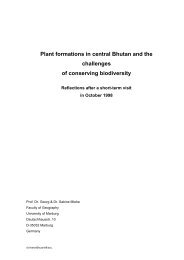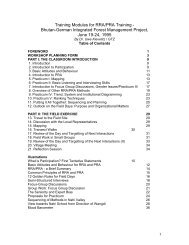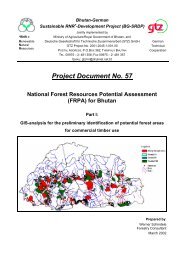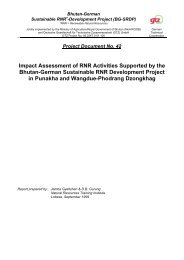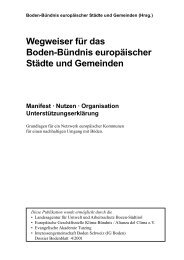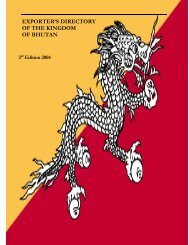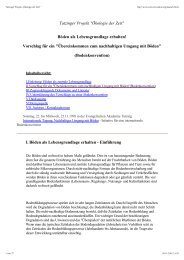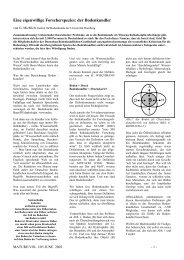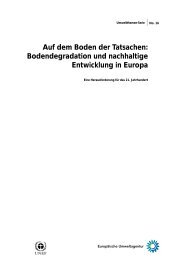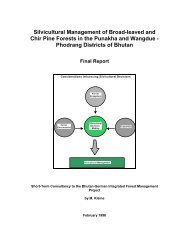GTZ Project Document No. 51 Report on Nahi Baseline Survey
GTZ Project Document No. 51 Report on Nahi Baseline Survey
GTZ Project Document No. 51 Report on Nahi Baseline Survey
Create successful ePaper yourself
Turn your PDF publications into a flip-book with our unique Google optimized e-Paper software.
<strong>Nahi</strong> <strong>Baseline</strong> <strong>Survey</strong> April- May 2001Table 2.11 Milking cows, breed and average milk yield/day/year• UN1 UN2 UN LN1 LN2 LN GrandVillage Nabesa Esagom Total Hebisa Esawom Total TotalTypes of cow (breed) 0 0 0 0 0 0 0Local 9 13 22 14 11 25 47Jersey 1 0 1 4 1 5 6Mithun 2 0 2 1 3 4 6Jersey cross 2 1 3 1 2 3 6Milking period (m<strong>on</strong>ths) 124 136 260 192 172 364 624Average milking period (m<strong>on</strong>ths) 18.7 18.91 37.61 19.88 20.22 40.09 77.71Total Milk (bottles/day) 33.5 25 58.5 43.5 43.5 87 145.5Average milk (bottles/day/cow) 2.39 1.79 4.18 2.18 2.56 4.73 8.91Total milk (bottles/yr) 10370 68250 78619 12673 13172 25845 104465Source: RRA <strong>Survey</strong> May 20012.4.2 Feed and FodderThe farm is the most important source of fodder for the livestock supplemented bygrazing in the forest. The most comm<strong>on</strong>ly available fodder <strong>on</strong> the farm is crop residuesand grazing in the field after harvest. However, a few farmers also grow some wheat andmaize especially for feeding their milking cows, the bulls and horses during the workinghours. At present no improved pasture are found in the valley.About 22 farmers (23%) from the total interviewed households collected some fodderfrom the forest especially during the winter seas<strong>on</strong>. Namgyel (1996) has identified about13 different fodder trees that are comm<strong>on</strong>ly used by the farmers in <strong>Nahi</strong> valley. Thequantificati<strong>on</strong> of fodder collected in a year is not possible as the farmers are not able toremember and provide the number of back loads collected in a year.The forest is the most comm<strong>on</strong> place where they graze their cattle. Grazing of cattle inthe forest is necessary especially during the seas<strong>on</strong>s when the fields are under crops.C<strong>on</strong>sidering the abundant forest coverage grazing in the forest is not a problem especiallyat the moment.The use of market feed is not comm<strong>on</strong> am<strong>on</strong>g farmers. Approximately about 9% (8) ofthe total resp<strong>on</strong>dents purchased cattle feed from the market, seven farmers from the upperand <strong>on</strong>e from the lower valley. The quantificati<strong>on</strong> is not possible as the resp<strong>on</strong>dents arenot able to provide the informati<strong>on</strong> except <strong>on</strong>e farmer menti<strong>on</strong>ed of purchasing about 2-3bags (100kg/bag) in a year.• [UN = Upper <strong>Nahi</strong>; UN1- Nabesa, UN2-Esagom; LN=Lower <strong>Nahi</strong>, LN1-Hebisa, LN2-Esawom,].1 bottle=750 ml.19



